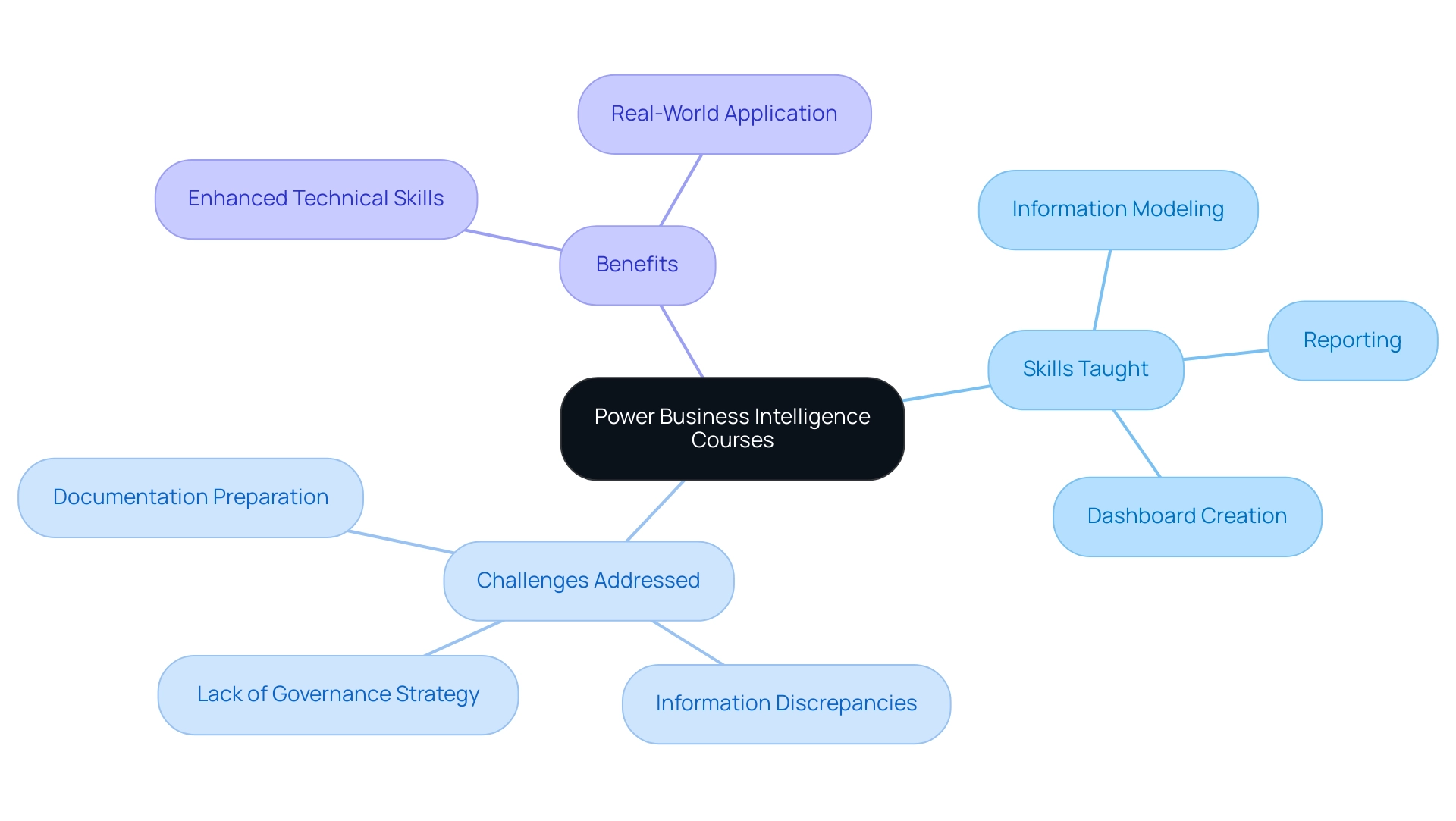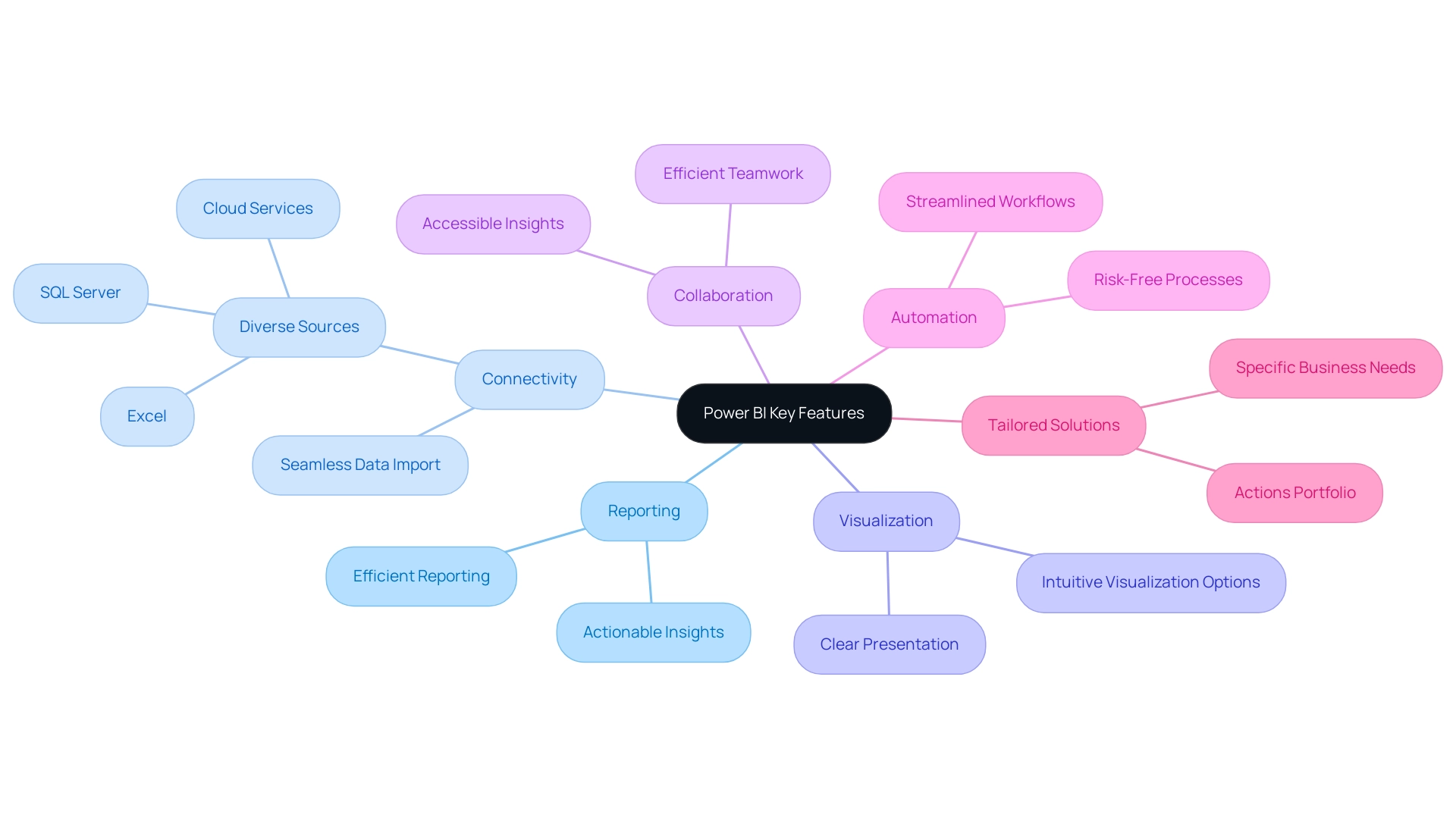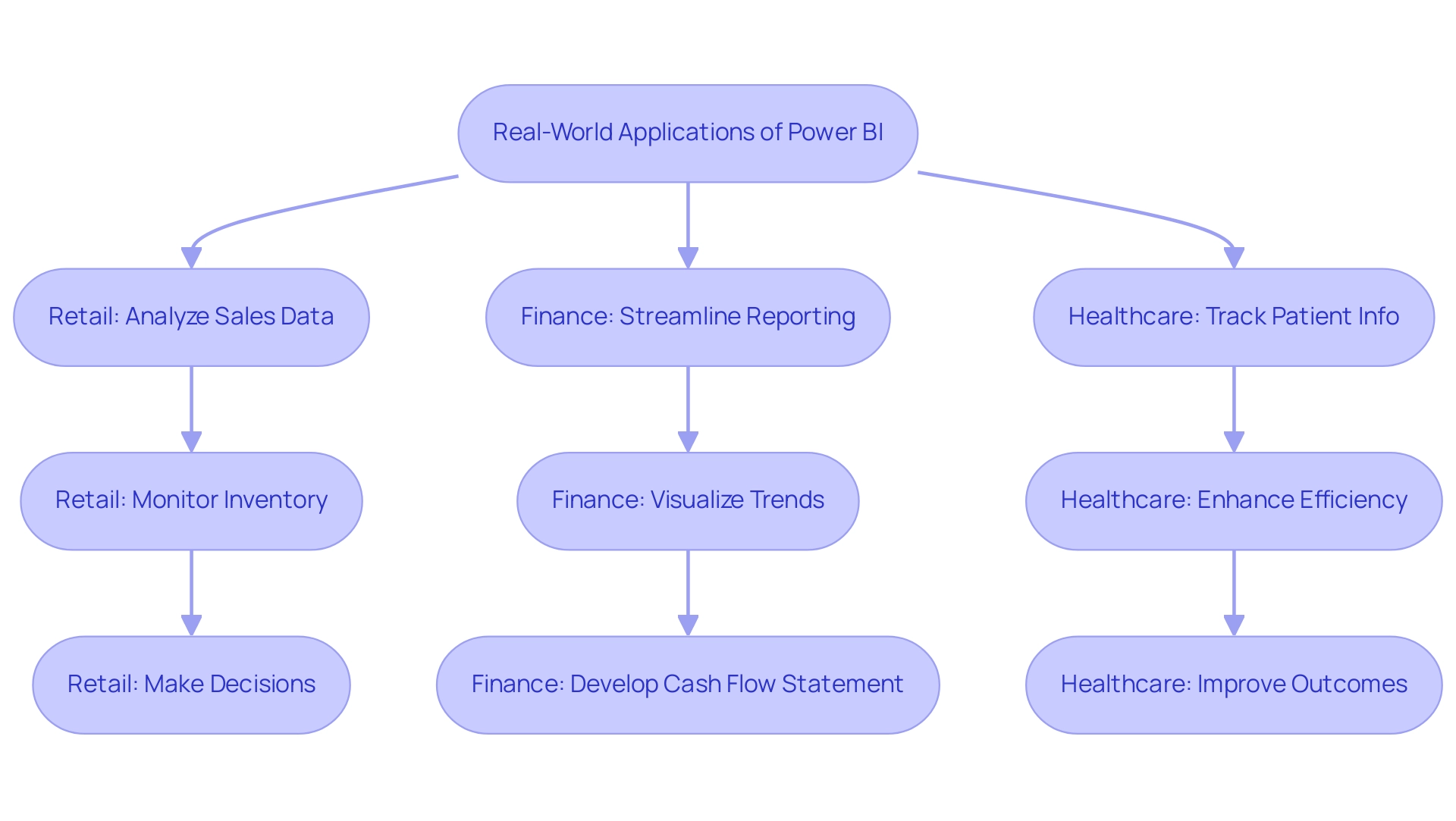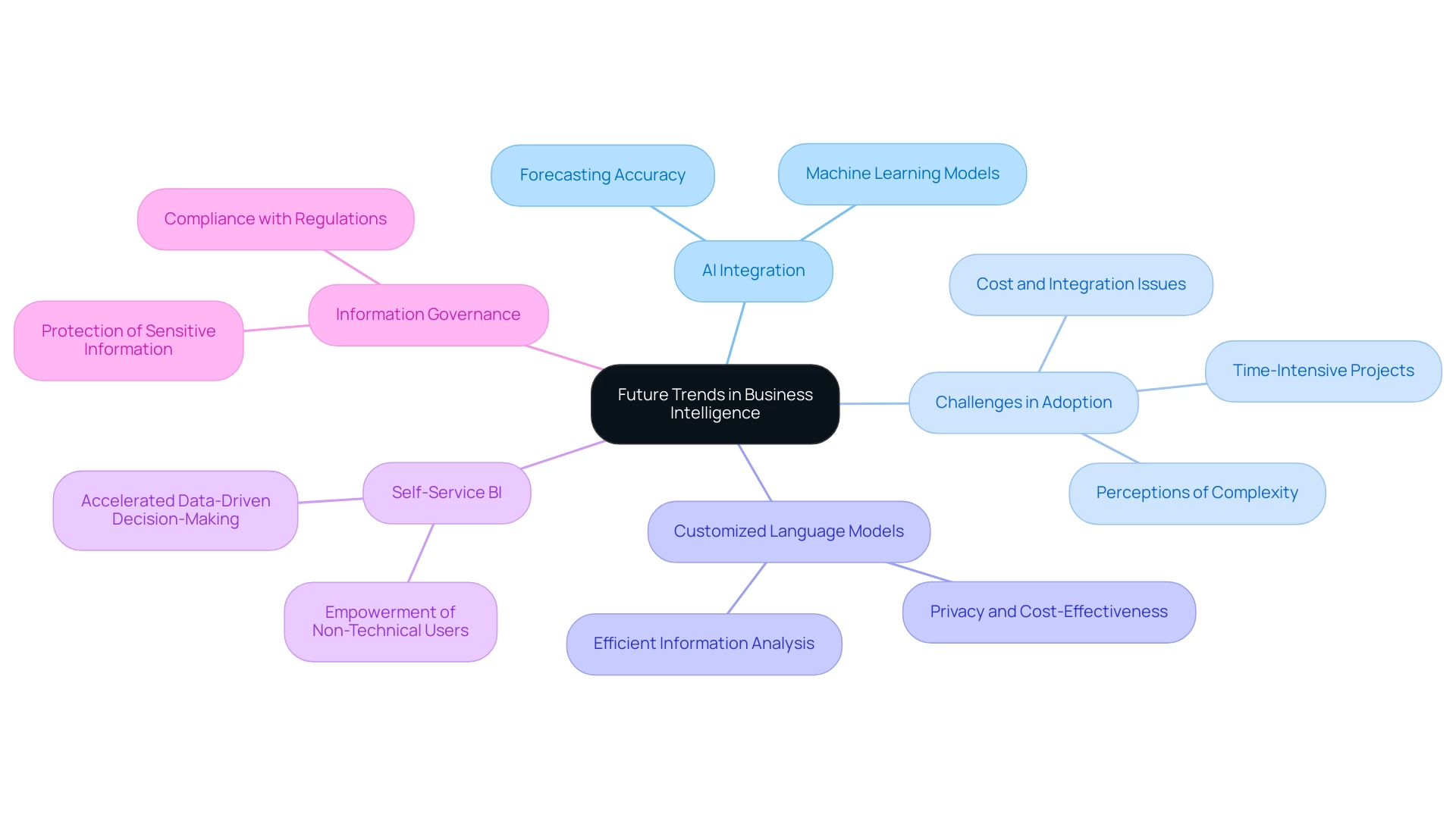Introduction
In the rapidly evolving world of business intelligence, the ability to transform raw data into actionable insights has never been more critical. Power Business Intelligence (BI) courses equip professionals with the essential skills needed to harness the full potential of Microsoft Power BI, a leading tool for data visualization and analytics. As organizations grapple with challenges such as inefficient report creation and inconsistent data, these courses provide practical solutions that empower individuals to streamline processes and enhance decision-making.
By mastering Power BI, participants not only improve their technical acumen but also learn to apply these skills in real-world scenarios, driving operational excellence and fostering a culture of data-driven insights. This article delves into the myriad benefits of Power BI training, the key features that set it apart, and its transformative applications across various industries, ultimately illuminating the path toward informed, agile decision-making in a data-centric landscape.
Introduction to Power Business Intelligence Courses
Business Intelligence (BI) courses, including the power business intelligence course, are structured to provide professionals with the skills needed to utilize Microsoft BI, a robust tool for visualization and business analytics. These courses cover essential concepts of information modeling, reporting, and dashboard creation, enabling users to transform raw information into meaningful insights that drive informed decision-making. In the current environment, where entities encounter obstacles such as lengthy documentation preparation, information discrepancies, and a deficiency of practical guidance, mastering Power BI becomes essential for streamlining operational procedures and improving overall effectiveness.
Specifically, these courses address the common pitfalls of inconsistent information across reports and the absence of a governance strategy, ensuring that participants can create reliable and actionable reports. By participating in the power business intelligence course, individuals not only enhance their technical skills but also learn to apply these skills to real-world business scenarios, empowering them to drive innovation and operational excellence within their organizations.

Benefits and Skills Acquired from Power BI Training
Completing a power business intelligence course opens a wealth of opportunities for professionals, significantly enhancing their visualization skills and analytical capabilities. Participants acquire the capability to connect to various information sources, clean and transform information, and utilize DAX (Data Analysis Expressions) for advanced calculations. These competencies enable professionals to present information in a more compelling and insightful manner, fostering a culture of evidence-based decision-making within their organizations.
In the context of today’s rapidly evolving AI landscape, integrating tailored AI solutions alongside Robotic Process Automation (RPA) can further enhance operational efficiency by automating repetitive tasks and providing intelligent insights. As data scientist Hilary Mason emphasizes, ‘the human aspect of analytics is crucial; intuition and questioning play vital roles in interpreting insights beyond mere algorithms.’ This emphasizes the significance of merging human insight with analytical tools, as shown in the case study titled ‘The Human Element in Data Analytics,’ which illustrates how such a combination results in more meaningful interpretations and applications of information.
By mastering Power BI and understanding the challenges of time-consuming report creation and inconsistencies, professionals not only streamline their reporting processes but also reduce the time spent on manual manipulation. RPA specifically tackles these challenges by automating the information gathering and reporting processes, ensuring consistency and accuracy in the information presented. Organizations utilizing the full potential of their information stand to gain significantly—research indicates that businesses are missing out on $5.2 million in revenue due to untapped resources.
Marissa Mayer recommends that companies should begin gathering information as early as possible to gain from its insights, emphasizing the urgency of embracing a power business intelligence course for effective BI training. Consequently, mastering BI, alongside leveraging RPA and tailored AI solutions, positions organizations for agile and informed decision-making, ultimately enhancing their competitive edge in a rapidly evolving landscape.

Understanding Power BI’s Key Features
Power BI is a robust business intelligence tool that is part of the power business intelligence course, distinguished by key features that significantly enhance reporting, efficient reporting, and actionable insights. It facilitates seamless connectivity, allowing users to import information from diverse sources such as Excel, SQL Server, and cloud services. With its powerful information modeling capabilities, professionals can create meaningful relationships between various datasets, leading to deeper analysis.
The intuitive visualization options empower users to present information in a clear and impactful manner, ensuring that insights resonate with stakeholders. Furthermore, BI’s sharing and collaboration features promote efficient teamwork, making insights readily accessible across teams. Combined with a 3-Day BI Sprint for rapid report creation and the comprehensive General Management App, these tools provide professionals the means to significantly elevate their data analysis and reporting processes in a power business intelligence course.
Embracing Automate also streamlines workflows and automates processes risk-free, ensuring that operational efficiency is realized with measurable ROI. Additionally, our Actions portfolio provides tailored solutions to meet specific business needs. By leveraging these features, Directors of Operations Efficiency can drive impactful decision-making and foster a culture of data-driven insights.
To explore these opportunities further, we invite you to book a free consultation.

Real-World Applications of Power BI
The power business intelligence course has emerged as a transformative tool across multiple industries, adeptly addressing specific business challenges. In the retail sector, companies utilize BI to conduct thorough analysis of sales information and oversee inventory levels, thereby facilitating informed decision-making concerning stock management and aligning offerings with customer preferences. However, many organizations face challenges such as investing excessive time in creating documents rather than leveraging insights from the power business intelligence course.
For example, the execution of an Order Summary Document enables real-time inventory monitoring and order rate calculation, improving inventory and order management while occasionally causing discrepancies in information across different documents due to an absence of governance strategy. Here, Robotic Process Automation (RPA) can streamline the report creation process, reducing the manual effort involved and allowing teams to focus on analysis instead of data gathering. In finance, organizations utilize BI to streamline financial reporting and forecasting processes, effectively visualizing trends and performance metrics.
As Naba Ijaz aptly notes,
This BI offers businesses an all-encompassing solution to navigate financial reporting challenges.
Developing a cash flow statement in BI involves organizing information with transaction details and ensuring proper relationships for accurate cash flow analysis, which is essential for effective financial oversight. Furthermore, BI’s advanced analytics capabilities make it a top choice for a power business intelligence course, enabling C-suite executives to leverage data-driven insights for strategic decision-making in financial reporting.
The healthcare industry also utilizes BI to track patient information and enhance operational efficiency, ultimately resulting in improved patient outcomes and resource distribution. The real-world applications highlight BI’s versatility and its crucial role in driving business success across various industries, while also emphasizing the importance of overcoming the common challenges faced in report creation and data governance. Tailored AI solutions further enhance these efforts by providing entities with specific tools to navigate the rapidly evolving technology landscape.

Future Trends in Business Intelligence and Power BI
The landscape of business intelligence is undergoing a significant transformation, particularly with the increasing integration of artificial intelligence (AI) and machine learning within tools like the power business intelligence course. However, many entities face challenges in adopting AI due to perceptions of complexity, cost, and integration issues, including the common belief that AI projects are time-intensive and costly. Addressing these challenges is crucial for enhancing operational efficiency.
For instance, our customized Small Language Models (SLMs) provide powerful capabilities for efficient information analysis, ensuring better privacy and cost-effectiveness. These models can assist entities in overcoming the obstacles presented by inadequate master information quality, which frequently results in ineffective operations and erroneous decision-making.
The power business intelligence course incorporates the integration of Azure Machine Learning within Power BI, offering access to a broad range of machine learning models and algorithms, enabling precise forecasts and predictions crucial for efficient operational planning. As entities grapple with the overwhelming AI landscape, leveraging solutions like SLMs can streamline the process and make AI technology more accessible. It is also essential for entities to comprehend where to begin with AI integration to ease their uncertainties.
Selecting between Machine Learning and Generative AI relies on the problem statement, information structure, and ethical considerations, making it vital for professionals to grasp these distinctions when implementing AI solutions. Furthermore, Bi’s anomaly detection capability enables report creators to automatically recognize irregularities in time series information, providing clear explanations and root cause analyses for detected anomalies, thereby improving the reliability of insights driven by information.
In addition, the trend towards self-service BI is democratizing access to information, permitting non-technical users to create their own reports and dashboards without excessive dependence on IT departments. This shift not only accelerates data-driven decision-making but also fosters a culture of empowerment across teams. As organizations increasingly prioritize information governance and security, the protection of sensitive information becomes paramount, ensuring compliance with ever-evolving regulations.
Staying informed about these emerging trends is crucial for professionals aiming to maximize the potential of Business Intelligence and maintain a competitive edge in their respective industries. The case study on forecasting with AI in the power business intelligence course exemplifies how machine learning algorithms improve the accuracy of forecasts, enabling more effective operational planning through the analysis of time-series and cross-sourced information. As Pierre Pinna aptly states,
The most important thing about AI is not the AI, no, the most important thing is the information!
This highlights the foundational role of data in harnessing the full capabilities of AI and machine learning in business intelligence.

Conclusion
Mastering Power Business Intelligence (BI) through dedicated training courses offers professionals a unique opportunity to transform raw data into impactful insights that drive informed decision-making. By acquiring essential skills in data modeling, reporting, and the use of Microsoft Power BI, individuals are well-equipped to tackle common challenges such as inefficient report creation and data inconsistencies. As organizations increasingly rely on data to enhance operational efficiency, the ability to streamline reporting processes becomes paramount.
The benefits of Power BI training extend beyond technical skills; they foster a culture of data-driven decision-making and innovation within organizations. By leveraging the powerful features of Power BI, including seamless data connectivity and intuitive visualization options, professionals can present data in ways that resonate with stakeholders and enhance collaboration across teams. This not only accelerates the decision-making process but also empowers organizations to harness the full potential of their data, ultimately driving competitive advantage.
Looking ahead, the integration of AI and machine learning into Power BI presents exciting opportunities for further enhancing data analysis and operational efficiency. As organizations navigate the complexities of these technologies, embracing tailored solutions can mitigate common adoption challenges. By staying informed about emerging trends and focusing on data governance, businesses can ensure they are prepared to leverage the full capabilities of Power BI, positioning themselves for success in an increasingly data-centric landscape.
The journey toward informed, agile decision-making begins with mastering these tools, enabling organizations to thrive in today’s fast-paced environment.

